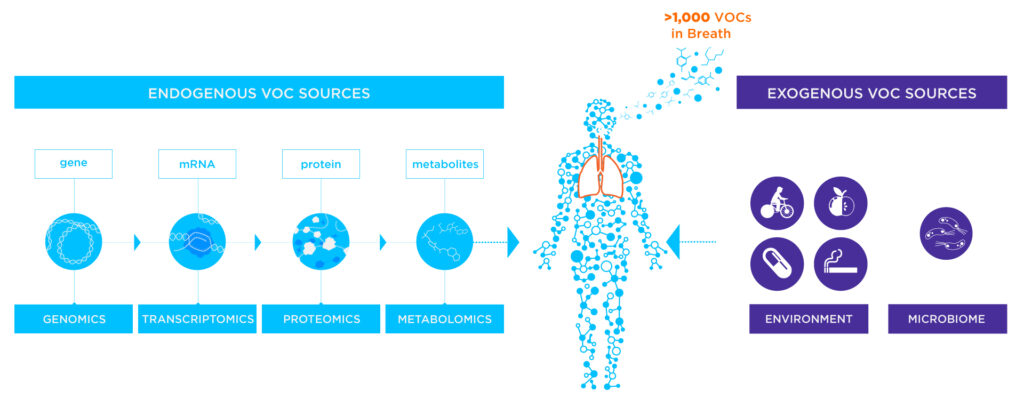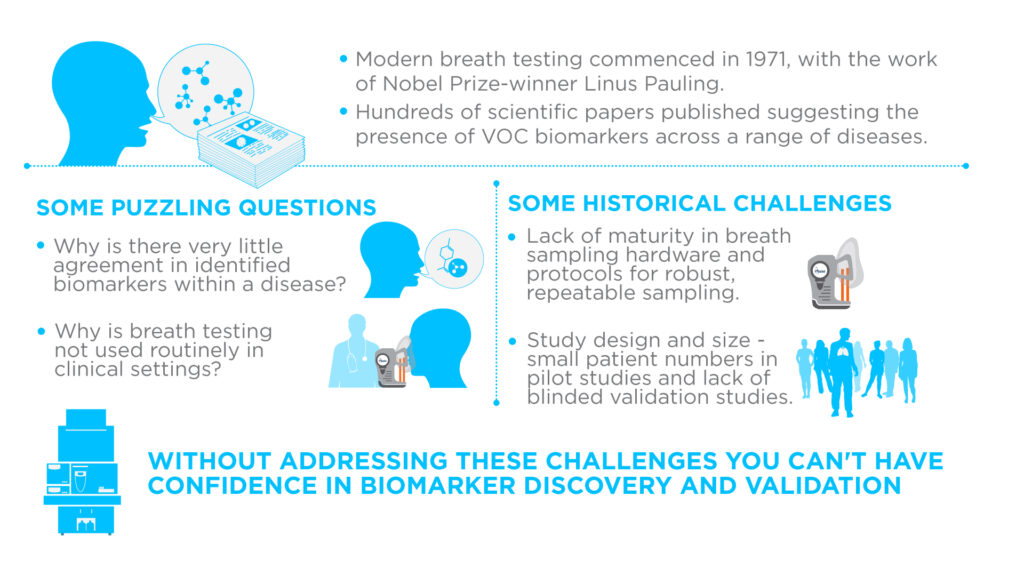Breath to Bodily Fluids: the Role of VOCs in Health and Disease
Published on: 25 Jan 2024
Volatile organic compounds (VOCs) are organic chemicals that are gaseous at room temperature and are present in a wide range of bodily fluids such as breath, blood, saliva, skin secretions, urine, feces, milk, and semen.
The endogenous VOCs produced by metabolic activity within the body are able to be used as biomarkers, and therefore is a powerful approach for early detection across a wide variety of disease areas. Similarly, VOCs from exogenous sources such as the microbiome, diet, and prescription drugs can also function as biomarkers to provide insight into disease progression, diagnosis, and monitoring.

VOCs in Different Bodily Fluids
The human body harbors a large variety of VOCs, collectively known as the human volatilome. This volatilome is made up of over 2700 VOCs, with more being found on breath than any other bodily fluid. Only 14 VOCs are found across all the bodily fluids described above, but there are many that appear in multiple of these matrices. The main form of analysis used to measure VOCs on bodily fluid samples is GC-MS, but PTR-MS, SIFT-MS, SPME, and TOFMS have all been used1.
Breath:
Research suggests 1488 named VOCs have been detected in exhaled breath. The most prominent of these VOCs are isoprene and acetone1. Isoprene originates from muscular lipolytic cholesterol metabolism and the levels in breath increase during physical exertion2. Acetone is produced during the oxidation of fatty acids and as such is affected by diet and exercise3. Many of the VOCs in breath are exogenous in origin, for example, short-chain fatty acids (SCFAs) are produced by the microbiome.
There is great potential for the use of breath-based VOCs as non-invasive biomarkers for a variety of disease areas including cancer, respiratory illness, cardiometabolic disease, and gastrointestinal conditions. For example, hydrogen and methane breath samples can be used to diagnose small intestinal bacterial overgrowth (SIBO) and carbohydrate malabsorption. Owlstone Medical is developing breath-based clinical tests for a number of diseases including lung cancer and liver cirrhosis to increase the proportion of people who are diagnosed early, and improve prognosis and survival.
Blood:
The 379 VOCs found in blood provide information on the metabolic activity of the body as a whole due to its rapid circulation. However, obtaining samples for analysis is an invasive process when compared to other fluids. VOCs circulating in the blood exchange into the air in the lungs at the alveolar membrane, and are therefore represented in breath.
A lot of the current research on blood-based VOCs focus on monitoring the exposure to exogenous compounds including environmental pollutants. One example of a clinical test involving sampling of blood VOCs is the quantification of ammonia levels. Higher levels of ammonia in the blood can indicate irregular nitrogen homeostasis, deriving from liver dysfunction1.
Saliva:
VOCs in saliva can provide insight into oral health and the oral microbiome. Like breath, it can be collected non-invasively however there is a possibility of contamination during collection. A total of 549 VOCs have been reported in saliva, of which hydrocarbons make up a significant proportion these (34%). Alcohols are the second most prevalent making up 16% of the VOCs found, followed by ketones (14%) and cyclic hydrocarbons (12%)1.
Skin Secretions:
Skin has been reported to secrete 623 VOCs. These can vary from a single individual and across a population as distribution of the different types of glands and microbiota, a person’s diet, and age will affect the profile of VOCs secreted. The chemical classes of VOCs found in skin secretions include alcohols, aldehydes, ketones, esters, fatty acids, hydrocarbons, and terpenes1.
Urine:
The largest number of the 444 VOCs related with urine are ketones. These are thought, in part, to be produced by the gut microbiome and in the liver through fatty acid oxidation. Acids, alcohols, aldehydes, amines, N-heterocycles, O-heterocycles, sulfur compounds and hydrocarbons are also found in urine. Alkanes are likewise present but are the least prevalent of these chemical classes.
VOCs in urine can be affected by a variety of factors. Concentrations of phenol and p-cresol have been identified as increasing in higher protein diets, associated with the action of the gut microbiome on tyrosine. Additionally, the presence of terpenes derived from food, indicate that dietary intake can influence the VOC profile in urine1, 4.
Feces:
443 VOCs have been identified from fecal samples. A significant number of these are volatile fatty acids, indoles, and phenols. The gut microbiome is responsible for the majority of these, for example fermentation of carbohydrates by bacteria like Bacteroides ferment carbohydrates, producing ethanoic, propionic, butanoic, pentanoic, and hexanoic acids. Other VOCs produced by the microbiome include alcohols, aromatic compounds, aldehydes, acetone, butan-2-one, methylketones, sulfur containing compounds and many hydrocarbons 1, 5.
Milk:
The 290 VOCs in human milk can be influenced by various factors, including storage conditions, ambient conditions, the mother’s diet during pregnancy and nursing. The identification and quantification of VOCs in milk may have implications for understanding lactation physiology and the transfer of dietary compounds to breast milk, which could be relevant for maternal and infant health1.
Semen:
196 compounds have been reported in semen, the most prevalent group of VOCs being nitrogen-containing volatiles, consisting of 30% of those identified. Analysis of these VOCs may provide insight on the metabolic profile of sperm cells and seminal fluid, which could affect sperm motility and thus fertility1.
Advantages of Breath Analysis
In addition to having more VOCs measurable in breath than other bodily fluids, there are many significant advantages to breath analysis. Breath sampling is non-invasive, improving patient comfort and increasing uptake for screening programs.
Like blood, breath can be used to measure VOCs originating from anywhere in the body as they diffuse from the circulatory system into the alveoli. Unlike blood, breath is inexhaustible, enabling a greater volume of sample to be taken and the compounds in breath samples to be pre-concentrated prior to analysis.
Breath samples reflect the metabolic activity of the body in real-time, avoiding the time-lag associated with measuring VOCs in fluids like urine and feces. The sampling is convenient for both participants and researchers, able to be undertaken anywhere, making it a practical approach for large-scale, decentralized studies.
Challenges and Future Directions
VOC analysis is less established than typical biomarker discovery approaches that use antibodies and proteins, and further research is needed to better understand the human volatilome and validate reported compounds.
The large number of identified VOCs present challenges in terms of data interpretation and comparison, making it difficult to assess and compare results. This is made more difficult through the combination of predominantly untargeted biomarker discovery approaches without adequate standardization, which can lead to a high number of false positives and variability between studies.
To address this crucial need for improved standardization and reproducibility we have created the VOC Atlas, the largest available dataset of VOCs “on-breath” and incorporated it into our Breath Biopsy® OMNI® workflow. The compounds within the VOC Atlas have been carefully confirmed for their presence in the breath, as opposed to originating from environmental contaminants and provide a baseline reference of statistically supported validated on-breath VOCs.
There is a lot of potential in using VOCs, especially those on-breath, as biomarkers for clinical research and practice. However, there is plenty of research and discovery to be done! At Owlstone Medical, we want to help unleash the full potential of breath-based VOCs. You can find out more about our VOC Atlas, and our research products and services or get in touch to incorporate Breath Biopsy into your breath sample collection and biomarker discovery workflow.
References:
- Drabińska N, Flynn C, Ratcliffe N, Belluomo I, Myridakis A, Gould O, Fois M, Smart A, Devine T, Costello BL. A literature survey of all volatiles from healthy human breath and bodily fluids: the human volatilome. J Breath Res. 2021 Apr 21;15(3). https://doi.org/10.1088/1752-7163/abf1d0
- Sukul, P., Richter, A., Junghanss, C. et al. Origin of breath isoprene in humans is revealed via multi-omic investigations. Commun Biol 6, 999 (2023). https://doi.org/10.1038/s42003-023-05384-y
- Bovey, F., Cros, J., Tuzson, B. et al. Breath acetone as a marker of energy balance: an exploratory study in healthy humans. Nutr & Diabetes 8, 50 (2018). https://doi.org/10.1038/s41387-018-0058-5
- E Bone, A Tamm, M Hill, The production of urinary phenols by gut bacteria and their possible ce:role in the causation of large bowel cancer, The American Journal of Clinical Nutrition, Volume 29, Issue 12, 1976, Pages 1448-1454, ISSN 0002-9165, https://doi.org/10.1093/ajcn/29.12.1448
- Bäckhed F, Ley RE, Sonnenburg JL, Peterson DA, Gordon JI. Host-bacterial mutualism in the human intestine. Science. 2005 Mar 25;307(5717):1915-20. https://doi.org/10.1126/science.1104816
